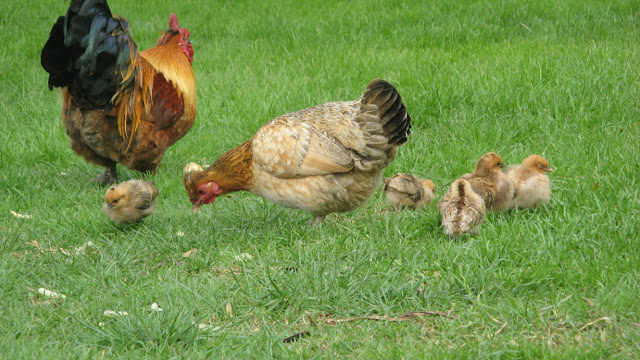When I stopped at the lookout/picnic area just south of town on Tuesday afternoon to my delight, six chickens boosted the number of wild fowl that live there. Mother hen was doing a good job of keeping them close and away from the road. Helped by earlier visitors who had scattered the last of their chips on the grass. A few times in the past I've seen the man who stops to feed them proper chook food a couple of times a week. The little flock knows the sound of his car and come running out of the bushes before he turns off the highway.
I was standing there again on Thursday, looking in vain for the rest of the chicks - but there were only two left. Another car pulled in and the young man who joined me, had a little bag of bread crusts for the birds and said there had been eight chickens on Monday. He collects food scraps from his mates in the lunchroom at work and stops to feed them a couple of times a week. "She's not a very good mother, this one. None of her chickens survived last year." Then, with a cheeky grin added, "That's what you get when you live on the wildside!"
All around the country little flocks of chickens live on the wildside, have taken up residence and thrived at roadside stops - picnic areas, scenic looksouts and the like. Sometimes these places are in the "middle of nowhere" miles from people or towns. At some stops they are a tourist attraction. I often wonder how they got there.
Some believe they are refugees from battery farms but I've seen them in isolated places where it is impossible to imagine this probability. Some flocks consist mostly of roosters and it is surmised that early morning and loud cock-a-doodle-doo-ing has led to them being thrown upon the roadside rather than killing them. But how do the hens find them? Because invariably there are a few hens in the mix.
However they get there, they are real survivors. They have to contend with rats, cats and roadside traffic. Mature birds learn to stay away from traffic but little chicks?
Invariably they look very healthy. They survive on what they can scratch around and find - insects, bugs, berries, with a bit of luck a nice far worm, and food thrown to them by passersby. No doubt there are other regular Good Samaritans in addition to the two I have met, who find pleasure in stopping to interact with the little flock I visit. Seems they eat just about anything. There are never food scraps laying around.
I've heard these little flocks described as Road Island Reds and Layby Leghorns. Would love to be able to think of something clever to call "my" birds.
And they are free. If I were a chook, this would be the life I'd choose.

A very nice post. I wonder why we don't have feral hens here.
ReplyDelete¤*¨¨*¤.¸¸ ...¸.¤\
ReplyDelete\ 9/11 R.I.P ~♥~ \
.\¸.¤*¨¨*¤ .¸¸.¸.¤*
..\
☻/
/▌
/ \ NEVER FORGET!!!
Thoughts & prayers. ~♥~
I love the thought of Rogue Hens!
ReplyDeleteToday we took yet another raccoon miles out into the bush. Our little flock is still locked in until we're sure there are no more daytime marauders.
Sounds like and idea for a Watership Down kind of novel, starring chickens instead of rabbits...
ReplyDeleteHello Pauline,
ReplyDeleteI remember those hens on the side of the road. A fantastic photo of the chickens.
Happy days.
Bev.xoxo
I've got photos of that little flock too. I suppose the adults are better able to fend off the marauders than the wee ones. Some must survive though or the flock will die out.
ReplyDelete